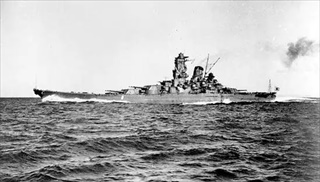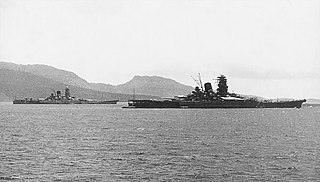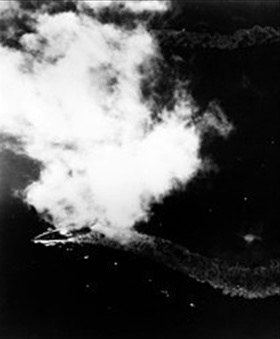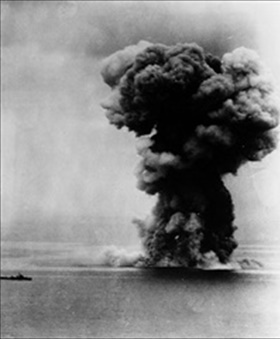DEATH OF BATTLESHIP YAMATO NEAR OKINAWA
East China Sea • April 7, 1945
On this date the Japanese super-battleship Yamato steamed toward Okinawa and to a martyr’s death dispensed by pilots from Rear Adm. Mark A. “Pete” Mitscher’s U.S. Fast Carrier Task Force 58 (TF58). Early in World War II, Mitscher commanded the Hornet, which from her deck famously launched Col. Jimmy Doolittle’s Raiders toward Japan’s capital, Tokyo, in April 1942. Eight weeks later Mitscher’s Hornet engaged the enemy in the Battle of Midway (June 1942), the first important U.S. victory after the Japanese surprise attack on Pearl Harbor the previous December. Now commanding the fast carriers of TF58, Mitscher stopped dead in its tracks a Japanese naval sortie centered on the Yamato, hell-bent on frustrating U.S. amphibious landings on Okinawa (since April 1). The 463‑square-mile/1,199‑square-kilometer island, owing to its proximity to the southernmost Japanese island of Kyūshū, was viewed in Tokyo as a precursor to a ground attack on the Japanese homeland itself.
Yamato was the pride of the Imperial Japanese Navy (IJN) when it joined the fleet in mid-February 1942. For a time Yamato served as the flagship of the IJN. From her bridge Adm. Isoroku Yamamoto, Commander-in-Chief of the Combined Fleet during World War II until his death in April 1943, directed the Japanese fleet during the Battle of Midway. The 3‑day engagement, wherein Yamamoto’s battleship group was too far from the scene of action, was the first of many disasters that inflicted irreplaceable losses on Japanese naval assets. Furthermore, it was a personal humiliation for Yamamoto, the battle’s principal planner.
Retired from flagship duties by twin super-battleship Musashi in January 1943, Yamato occasionally plied the Pacific Ocean between Japan’s Kure naval base on the main island of Honshū and Micronesia’s Truk (Chuuk), Japan’s stronghold and forward anchorage in the South Pacific. At Truk Yamato settled into battleship slumber by serving as a headquarters ship and officers’ billet, derisively called “Hotel Yamato.” From time to time the battleship performed a few piddling missions; e.g., ferrying troops and supplies to Japan’s island garrisons.
On April 6, 1945, Yamato, Vice Admiral Seiichi Itō commanding, took on the mission of a lifetime as part of Operation Ten-Go (Operation Heaven One). Leaving on that date from Tokuyama Harbor (modern Shūnan) on the southern tip of Honshū in the company of 8 destroyers, 1 light cruiser, but no air cover, Itō had orders to beach Yamato at Hagushi Bay not far north of Naha, capital city of Okinawa, where the mighty battleship would foil ongoing American amphibious landings of men and supplies. Yamato’s crewmembers were to either man the ship’s 166 antiaircraft guns, including her 3 triple 18.1‑in/42‑mm guns, and fight to their deaths or link up with Okinawa’s 100,000-man garrison. While Yamato was still over 150 nautical miles/179 kilometers from her destination, U.S. flying boats continuously alerted Mitscher’s Task Force 58 to the enemy’s course, speed, and position. The surface battle Adm. Itō had hoped for instead became a one-sided aerial tussle as close to 300 U.S. carrier F6F Hellcat and F4U Corsair fighters and TBM Avenger torpedo bombers rained steel death on the kamikaze armada beneath them.
Due to extensive bomb and torpedo damage, Yamato began listing to port. That’s when torpedo bombers noticed this weakness and released more loads. In all 11 to 13 found their mark. In an action that drowned 300 sailors, 2 sections in the ship were purposely flooded to prevent the vessel from capsizing. The ship listed at least 30 degrees when Itō ordered abandon ship. With the fleet’s radio gear inoperable, Itō used signal flags to commence rescue operations. Yamato rolled over to port at 2:20 p.m. and 3 minutes later exploded, sending a mushroom cloud 20,000 feet/6,096 meters into the air and producing a sound heard on Kyūshū 100 miles/161 kilometers away. Between 3,700 and 4,250 men aboard Yamato and her escort ships perished. Of Yamato’s 3,000-man crew just 269 survived. American losses were 10 planes and a dozen lives. Yamato’s suicide ride was the last major Japanese naval operation in World War II. The U.S. declared Okinawa secure on June 21, 1945, after an intense and costly battle.
Yamato: Largest One-Way Kamikaze of World War II
 |  |
Above: Yamato during sea trials, 1941 (left frame), and Yamato and Musashi (foreground) in Truk Lagoon, early 1943 (right frame). Yamato, archaic name for Japan, and sister ship Musashi were built in secret. Displaying 71,659 tons fully loaded and with a beam of 127.7 feet/8.44 meters and a length of 863 feet/263 meters, the super-battleships were designed to carry 9 18.1‑inch/460‑mm main guns, withstand 18‑inch shellfire from an enemy, and have enough underwater armor to prevent damage from a torpedo carrying a 660‑pound/299‑kilogram warhead, while having a top speed of 27 knots/31 mph) and the ability to cruise 8,000 miles/12,875 kilometers at an average speed of 18 knots/20.7 mph. Laid down in November 1937, commissioned in mid-December 1941, Yamato completed sea trials in late May 1942 but avoided engagement during the Battle of Midway at the start of June. A year and a half later, on December 25, 1943, while ferrying troops and equipment to Truk, Yamato was torpedoed by a U.S. submarine, USS Skate, and suffered moderate damage that required repairs in Truk and then Kure. Musashi was torpedoed the next month and later that year, on October 24,1944, during the Battle of Leyte Gulf Musashi was sunk by an estimated 19 torpedo and 17 bomb hits from American carrier-based aircraft. During the same battle, after Yamato fired her main guns (the only battle in which she fired her big boys in anger at surface targets), the super-battleship and her escorts were chased off by a light escort carrier group of the U.S. Navy’s Task Force 77, “Taffy 3,” which was mistaken for a powerful U.S. carrier fleet. Yamato suffered multiple bomb hits, took on 3,000 tons of water, but by taking evasion action managed to retreat with her escorts. Tail between her legs, Yamato was back in Kure by November 23, 1944.
 |  |
Left: Yamato desperately maneuvers hard to port to avoid incoming U.S. Navy carrier planes northwest of Okinawa in the East China Sea, April 7, 1945. (Operation Ten-Go is sometimes known as the Battle of the East China Sea—the East China Sea being the location of the lethal sea and air encounter.) Prior to the attack the mighty ship maneuvered evasively at a brisk 15 to 20 knots. The photo was taken by a plane from the aircraft carrier USS Yorktown. A fire can be seen amidships from previous attacks, but at this point Yamato had not developed a list.
![]()
Right: A massive column of smoke rises (appropriately) to the heavens shortly after Yamato capsized, exploded due to burst air pressure as well as to detonating aft magazines, and sank thanks to the initiatives of her American tormentors. An unidentified enemy destroyer is visible to the left of the smoky column. Maybe the destroyer in the photo was the same one said to be severely damaged in the afternoon melee. Maybe it was among the three hostile destroyers that settled on the seafloor. Or maybe it was among the four that escaped to serve Emperor Hirohito another day. Photographed from a plane from the USS Yorktown.
Yamato: Life and Death of a Legendary Battleship
![]()

 History buffs, there is good news! The Daily Chronicles of World War II is now available as an ebook for $4.99 on Amazon.com. Containing a year’s worth of dated entries from this website, the ebook brings the story of this tumultuous era to life in a compelling, authoritative, and succinct manner. Featuring inventive navigation aids, the ebook enables readers to instantly move forward or backward by month and date to different dated entries. Simple and elegant! Click
History buffs, there is good news! The Daily Chronicles of World War II is now available as an ebook for $4.99 on Amazon.com. Containing a year’s worth of dated entries from this website, the ebook brings the story of this tumultuous era to life in a compelling, authoritative, and succinct manner. Featuring inventive navigation aids, the ebook enables readers to instantly move forward or backward by month and date to different dated entries. Simple and elegant! Click 











